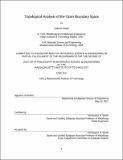| dc.contributor.advisor | Christopher A. Schuh. | en_US |
| dc.contributor.author | Patala, Srikanth | en_US |
| dc.contributor.other | Massachusetts Institute of Technology. Dept. of Materials Science and Engineering. | en_US |
| dc.date.accessioned | 2012-03-16T14:42:08Z | |
| dc.date.available | 2012-03-16T14:42:08Z | |
| dc.date.copyright | 2011 | en_US |
| dc.date.issued | 2011 | en_US |
| dc.identifier.uri | http://hdl.handle.net/1721.1/69667 | |
| dc.description | Thesis (Ph. D.)--Massachusetts Institute of Technology, Dept. of Materials Science and Engineering, 2011. | en_US |
| dc.description | This electronic version was submitted by the student author. The certified thesis is available in the Institute Archives and Special Collections. | en_US |
| dc.description | Cataloged from PDF version of thesis. | en_US |
| dc.description | Includes bibliographical references (p. 117-125). | en_US |
| dc.description.abstract | Grain boundaries and their networks have a profound influence on the functional and structural properties of every class of polycrystalline materials and play a critical role in structural evolution and phase transformations. Recent experimental advances enable a full crystallographic characterization, including the boundary misorientation and inclination parameters, of grain boundaries. Despite these advances, a lack of appropriate analytical tools severely undermines our ability to analyze and exploit the full potential of the vast amounts of experimental data available to materials scientists. This is because the topology of the grain boundary space is unknown and even a well-studied part of the complete grain boundary space, the misorientation space, is relatively poorly understood. This thesis summarizes efforts to improve the representation of misorientation information and to understand the topology of the complete grain boundary space. First, the topology of the space of misorientations is discussed with a focus on the effect of symmetries on the minimum embedding dimensions in Euclidean space. This opens the door to a new method of representation of misorientation information in which grain boundaries can be uniquely colored by their misorientations. Second, conditions under which the topology of the grain boundary space has been resolved are presented. Resolving the topology of the complete grain boundary space not only facilitates statistical analysis of grain boundaries, but can also help describe the structure-property relationships of these interfaces. | en_US |
| dc.description.statementofresponsibility | by Srikanth Patala. | en_US |
| dc.format.extent | 125 p. | en_US |
| dc.language.iso | eng | en_US |
| dc.publisher | Massachusetts Institute of Technology | en_US |
| dc.rights | M.I.T. theses are protected by
copyright. They may be viewed from this source for any purpose, but
reproduction or distribution in any format is prohibited without written
permission. See provided URL for inquiries about permission. | en_US |
| dc.rights.uri | http://dspace.mit.edu/handle/1721.1/7582 | en_US |
| dc.subject | Materials Science and Engineering. | en_US |
| dc.title | Topological analysis of the grain boundary space | en_US |
| dc.type | Thesis | en_US |
| dc.description.degree | Ph.D. | en_US |
| dc.contributor.department | Massachusetts Institute of Technology. Department of Materials Science and Engineering | |
| dc.identifier.oclc | 777366702 | en_US |
